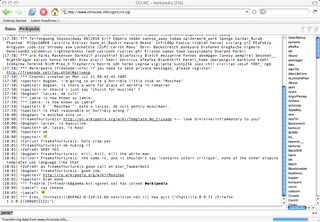
Hyphanet is a peer-to-peer platform for censorship-resistant, anonymous communication. It uses a decentralized distributed data store to keep and deliver information, and has a suite of free software for publishing and communicating on the Web without fear of censorship. Both Freenet and some of its associated tools were originally designed by Ian Clarke, who defined Freenet's goal as providing freedom of speech on the Internet with strong anonymity protection.

In computer networking, a proxy server is a server application that acts as an intermediary between a client requesting a resource and the server providing that resource. It improves privacy, security, and performance in the process.
SOCKS is an Internet protocol that exchanges network packets between a client and server through a proxy server. SOCKS5 optionally provides authentication so only authorized users may access a server. Practically, a SOCKS server proxies TCP connections to an arbitrary IP address, and provides a means for UDP packets to be forwarded.

In computer networking, port forwarding or port mapping is an application of network address translation (NAT) that redirects a communication request from one address and port number combination to another while the packets are traversing a network gateway, such as a router or firewall. This technique is most commonly used to make services on a host residing on a protected or masqueraded (internal) network available to hosts on the opposite side of the gateway, by remapping the destination IP address and port number of the communication to an internal host.
A BNC is a piece of software that is used to relay traffic and connections in computer networks, much like a proxy. Using a BNC allows a user to hide the original source of the user's connection, providing privacy as well as the ability to route traffic through a specific location. A BNC can also be used to hide the true target to which a user connects.
In computer networks, a tunneling protocol is a communication protocol which allows for the movement of data from one network to another. It involves allowing private network communications to be sent across a public network through a process called encapsulation.

CGI:IRC is a CGI program written in Perl that allows access to IRC via a web browser. It is designed to be flexible and has many uses such as an IRC gateway for an IRC network, a chat-room for a website or to access IRC when stuck behind a restrictive firewall.
A home server is a computing server located in a private computing residence providing services to other devices inside or outside the household through a home network or the Internet. Such services may include file and printer serving, media center serving, home automation control, web serving, web caching, file sharing and synchronization, video surveillance and digital video recorder, calendar and contact sharing and synchronization, account authentication, and backup services.
An anonymizer or an anonymous proxy is a tool that attempts to make activity on the Internet untraceable. It is a proxy server computer that acts as an intermediary and privacy shield between a client computer and the rest of the Internet. It accesses the Internet on the user's behalf, protecting personal information of the user by hiding the client computer's identifying information. Anonymous proxy is the opposite of transparent proxy, which sends user information in the connection request header.
GTunnel is a Windows application developed by Garden Networks which sets up a local HTTP or SOCKS proxy server which tunnels traffic through their server farm before it reaches its intended destination.

GraphOn GO-Global is a multi-user remote access application for Windows. GO-Global is a product of GraphOn Corporation.

UltraSurf is a freeware Internet censorship circumvention product created by UltraReach Internet Corporation. The software bypasses Internet censorship and firewalls using an HTTP proxy server, and employs encryption protocols for privacy.
Internet censorship circumvention, also referred to as going over the wall or scientific browsing in China, is the use of various methods and tools to bypass internet censorship.

Google Safe Browsing is a service from Google that warns users when they attempt to navigate to a dangerous website or download dangerous files. Safe Browsing also notifies webmasters when their websites are compromised by malicious actors and helps them diagnose and resolve the problem. This protection works across Google products and is claimed to “power safer browsing experiences across the Internet”. It lists URLs for web resources that contain malware or phishing content. Browsers like Google Chrome, Safari, Firefox, Vivaldi, Brave and GNOME Web use these lists from Google Safe Browsing to check pages against potential threats. Google also provides a public API for the service.
Flash proxy is a pluggable transport and proxy which runs in a web browser. Flash proxies are an Internet censorship circumvention tool which enables users to connect to the Tor anonymity network via a plethora of ephemeral browser-based proxy relays. The essential idea is that the IP addresses contingently used are changed faster than a censoring agency can detect, track, and block them. The Tor traffic is wrapped in a WebSocket format and disguised with an XOR cipher.
Hotspot Shield is a public VPN service operated by AnchorFree, Inc. Hotspot Shield was used to bypass government censorship during the Arab Spring protests in Egypt, Tunisia, and Libya.

Lantern is a free internet censorship circumvention tool that operates in some of the most extreme censorship environments, such as China, Iran, and Russia. It uses wide variety of protocols and techniques that obfuscate network traffic and/or co-mingle traffic with protocols censors are reluctant to block. It also uses domain fronting. It is not an anonymity tool like Tor.

Shadowsocks is a free and open-source encryption protocol project, widely used in China to circumvent Internet censorship. It was created in 2012 by a Chinese programmer named "clowwindy", and multiple implementations of the protocol have been made available since. Shadowsocks is not a proxy on its own, but (typically) is the client software to help connect to a third-party SOCKS5 proxy, which is similar to a Secure Shell (SSH) tunnel. Once connected, internet traffic can then be directed through the proxy. Unlike an SSH tunnel, shadowsocks can also proxy User Datagram Protocol (UDP) traffic.
Outline VPN is a free and open-source tool that deploys Shadowsocks servers on multiple cloud service providers. The software suite also includes client software for multiple platforms. Outline was developed by Jigsaw, a technology incubator created by Google.[3]
A virtual private network (VPN) service provides a proxy server to help users bypass Internet censorship such as geoblocking and users who want to protect their communications against data profiling or MitM attacks on hostile networks.








